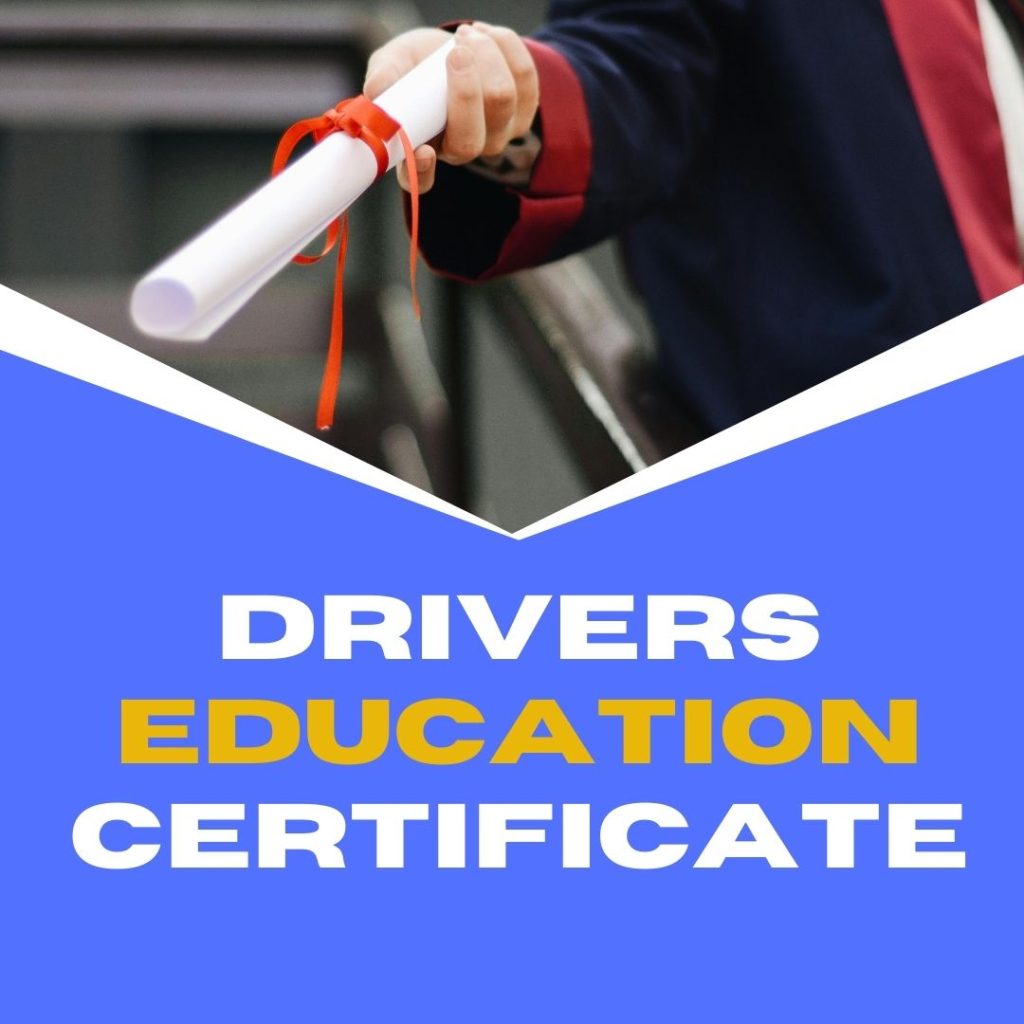Drivers Education Certificate: Unlock Road Freedom!
A Drivers Education Certificate verifies completion of a driver’s education course. Successful students receive it as recognition of their newfound driving knowledge.
Embarking on the journey to become a responsible driver typically starts with a comprehensive driver’s education program. This course equips novice drivers with the essential road safety rules, driving laws, and practical skills needed for operating a vehicle. For many, obtaining a Drivers Education Certificate is a crucial step toward earning a learner’s permit or driver’s license.
This certificate serves as a testament to the individual’s commitment to learning and is frequently a requirement by many state departments of motor vehicles. It’s pivotal for young drivers to learn from certified professionals to ensure they gain a solid grounding in driving principles, which ultimately promotes safer driving habits on the road.
Road To Independence: The Significance Of A Driver’s Education Certificate
The journey from the passenger seat to the driver’s seat marks a significant milestone. A Driver’s Education Certificate represents more than just a piece of paper; it’s a key to newfound freedom. Unlocking this independence requires understanding its importance.
Gateways To On-the-road Autonomy
Earning a Driver’s Education Certificate is the first step towards on-the-road autonomy. This certificate validates that a new driver has
- Mastery of traffic rules
- Understanding of road signs
- Essential driving skills
- Experience behind the wheel
New drivers gain confidence in handling a vehicle responsibly. They learn decision-making skills for real-world driving scenarios. Emphasis is on safeguarding oneself and others on the road.
Legal And Safety Implications
A Driver’s Education Certificate carries legal weight. Without it, young drivers cannot obtain a learner’s permit or driver’s license in many regions. This certificate
- Is evidence of formal driving education
- Ensures understanding of vehicular laws
- Signifies commitment to road safety
These credentials demonstrate a driver’s preparedness for safe and law-abiding driving practices. The training helps to reduce accidents, promoting public safety.

The Journey Begins: Enrolling In A Driver’s Ed Course
The first step to vehicular independence starts with driver’s education. This crucial training equips new drivers with the needed skills and knowledge. Learning the rules of the road and driving techniques builds a strong foundation for safe driving habits.
Choosing the right Driver’s Ed program marks the beginning of this journey. It’s not just about learning to steer or accelerate. It’s about understanding traffic laws, vehicle dynamics, and responsibilities as a driver. This process ensures confidence behind the wheel.
Researching The Right Program
Selecting the perfect Driver’s Ed program is vital. Several factors can influence this decision:
- Reputation: Look for programs with positive reviews and high success rates.
- Curriculum: Ensure the course covers comprehensive driver education.
- Instructors: Qualified and experienced teachers are essential.
- Flexibility: Consider schedules and locations that fit your needs.
- Cost: Find a program that suits your budget while maintaining quality.
Remember to ask friends or family for their recommendations. Personal experiences can guide you to reliable programs.
Understanding State Requirements
Driver’s Ed requirements differ across states. It’s important to understand these specifics:
| State | Age Requirement | Course Hours | Additional Requirements |
|---|---|---|---|
| California | 15-17 years | 30 hours | 6 hours of behind-the-wheel training |
| Texas | 14-17 years | 32 hours | Parent-taught option available |
Check the Department of Motor Vehicles (DMV) website for your state’s specifics. Age, course length, and additional practice hours are key details. Fulfilling these ensures eligibility for a learner’s permit or driver’s license.
Behind The Wheel: What To Expect During Training
Earning your Drivers Education Certificate is an exciting journey. It marks a significant step towards independence and mobility. But before you can enjoy the freedom of the open road, you need to understand what to expect during your driver’s training. This phase is not just about learning to turn the ignition or press the pedals—it’s a comprehensive program designed to equip you with the skills and knowledge to drive safely and responsibly.
Classroom Theory Vs. Practical Driving Experience
Driver’s education encompasses two essential components: classroom theory and practical driving experience. The balance between these parts is crucial for a well-rounded understanding of driving.
- Classroom sessions introduce the principles of safe driving.
- Hands-on lessons take these principles to the streets.
Expect interactive sessions, quizzes, and even virtual simulations in the classroom. Behind the wheel, your instructor will guide you through real-world driving situations. You’ll practice starting, stopping, steering, and navigating traffic.
Mastering The Rules Of The Road
Knowing traffic laws is essential for every driver. Your training will cover everything from traffic signals to road signage. You’ll learn the importance of speed limits and proper lane usage.
| Topic | Details |
|---|---|
| Signs and Signals | Identifying and obeying all road signs and signals |
| Right-of-Way | Understanding who has the right-of-way in different scenarios |
| Parking Rules | Learning various parking techniques and regulations |
Your instructor will also emphasize defensive driving practices to prepare you for unexpected situations. You’ll engage in role-playing exercises to understand the consequences of distracted driving.
During your behind-the-wheel sessions, focus on perfecting your turns, merges, and ability to drive under different conditions like night and adverse weather. Each practice session is a step towards becoming a skilled driver.
Supervised Driving: Gaining Confidence And Skill
Embarking on the journey toward driving independence, the Driver’s Education Certificate is a pivotal milestone for many young drivers.
This rite of passage, however, is not just about classroom theory; it requires hands-on practice behind the wheel.
Supervised driving sessions bridge the gap between knowledge and experience, fostering a newfound confidence and sharpening on-road skills.
The Role Of A Licensed Supervisor
A licensed supervisor plays a critical role in the learning process.
This mentor, typically a parent or a driving instructor, ensures safety while allowing the learner to explore the nuances of driving.
Active guidance and constructive feedback from a seasoned driver propel a novice from the basics to more complex driving scenarios.
- Building Trust: The supervisor’s calm presence instills comfort.
- Providing Instruction: Immediate advice helps tackle challenging situations.
- Safety First: A supervisor ensures adherence to driving laws and regulations.
Logging Practice Hours
Consistent practice is essential in mastering driving skills.
Most states mandate a certain number of supervised driving hours to qualify for a driver’s license.
Logging these hours provides structured development and readiness for solo driving.
| Activity | Hours Required | Note |
|---|---|---|
| Daytime Driving | 30 hours | Focus on visibility and control. |
| Nighttime Driving | 10 hours | Practice with reduced visibility. |
Logbooks or apps help track progress towards the required hours.
Celebrating each milestone along the way nurtures a positive learning attitude.
Testing For Success: Passing The Driving Exam
Embarking on the journey to acquire a Drivers Education Certificate is a monumental step. Congratulations on reaching this point! The path toward freedom and responsibility hinges on two critical assessments: the written and road tests. Mastering these exams proves your readiness to hit the road with confidence.
The Written Test: Proving Your Knowledge
To lay a solid foundation for driving expertise, you must first conquer the written test. This challenge checks your understanding of the rules of the road. It covers everything from traffic signs to safe driving practices.
- Study the driver’s manual: It’s full of answers to the test questions.
- Take practice tests: These mimic the actual exam and help identify areas for improvement.
- Memorize key concepts: Road signs, signals, and markings are crucial to know by heart.
The Road Test: Demonstrating Your Driving Aptitude
Success on the written exam brings you to the exciting road test. Here, you showcase your driving skills in a real car, on real roads. An instructor joins you, assessing your ability to drive safely and legally.
| Area of Assessment | Tips for Success |
|---|---|
| Vehicle Control | Practice steering, reversing, and parking with precision. |
| Observation | Constantly check mirrors and surroundings for hazards. |
| Signaling and Turning | Signal well before turns; execute them with care. |
| Following Traffic Laws | Obey all signs, signals, and road markings. |
Regular practice is your best tool to pass the road test. Familiarize yourself with the vehicle you will use. Know its controls and quirks. Stay calm and focused, recalling the skills you honed with each mile driven. Approach the test with a positive mindset, ready to demonstrate your aptitude behind the wheel.
The Certificate In Hand: Unlocking New Opportunities
The moment you have your Drivers Education Certificate in hand, the roads to numerous opportunities swing wide open. Whether it’s saving money on insurance or landing a job that requires driving skills, this certificate is more than just a license to drive—it’s a key to unlocking doors to a brighter future.
Insurance Premium Benefits
Securing a Drivers Education Certificate may lead to significant savings on car insurance. Insurance companies often view certified drivers as lower-risk clients. Here’s what certified drivers might enjoy:
- Discounted rates: A possible decrease in annual premiums.
- Good student discounts: Extra benefits for those excelling in their certified program.
- Fewer infractions: A track record of safe driving often results in cost savings.
Broadening Employment Prospects
With a Drivers Education Certificate, job opportunities that require driving as a core skill are now within reach. Here’s how this certificate can enhance your job search:
| Job Type | Requirements | Benefits |
|---|---|---|
| Delivery Driver | Solid driving skills | Flexibility and autonomy |
| Ride-Share Driver | Customer service & navigation | Earn on your schedule |
| Commercial Driver | Special endorsements | Higher pay rates |
These positions value the certification and often offer competitive pay and flexible hours, making them desirable for many individuals.
Staying Safe And Responsible On The Road
Earning a Drivers Education Certificate is just the beginning of a journey on the road. Being a confident driver means understanding the importance of safety and responsibility. Every time we sit behind the wheel, we hold the lives of ourselves and others in our hands. It’s crucial to stay informed and follow the best practices for driving.
Continued Learning And Driver Safety Courses
The road to becoming a better driver is endless. Traffic laws and best practices evolve. Continued learning helps you keep up. Many opt for Driver Safety Courses even after receiving their certificates.
- Refresh Traffic Laws: Rules can change. Stay updated.
- Advanced Techniques: Learn defensive driving skills.
- Discounts on Insurance: Some insurers give discounts for extra courses.
Adapting To Diverse Driving Conditions
Roads change and so should your driving. Adapting to diverse driving conditions is crucial for safety. Weather, traffic, and road types vary.
| Condition | Tips for Safe Driving |
|---|---|
| Rain: | Slow down, keep distance. |
| Snow: | Use chains, brake early. |
| Night: | Use low beams in fog, be alert. |
Take courses focusing on these conditions. Engage with interactive tools that simulate these scenarios. This helps in making quick and correct decisions when they happen for real.

The Bigger Picture: How Driver’s Education Promotes Safer Roads
Understanding the role of driver’s education is crucial in reducing road mishaps. This formal training helps new drivers gain critical skills. It molds them into responsible motorists. Programs across the globe focus on the practical aspects of being behind the wheel. They highlight the importance of road rules and safety protocols. By preparing individuals for various traffic situations, driver’s education lays the groundwork for safer roads for everyone.
Contributing To Traffic Safety Culture
Driver’s education does more than teach driving skills. It instills a culture of safety. Young drivers learn the impact of their decisions on the road. Educators stress the importance of attentive driving and responsible behavior.
- Wearing seat belts
- Observing speed limits
- Understanding right-of-way rules
- Recognizing road signs and signals
This training supports a collective movement towards safer roads.
Impact On Accident Statistics
Numbers tell a compelling story about the effects of driver’s education. Statistics reflect fewer crashes among trained individuals. Accredited courses provide knowledge that helps avoid common driving errors.
| Without Driver’s Ed | With Driver’s Ed |
|---|---|
| Higher accident rates | Reduced collision incidents |
| Increased traffic violations | Fewer legal infractions |
The data underscores the vital role of driver’s education in promoting safety. Knowledgeable drivers contribute significantly to reducing accidents. This leads to fewer injuries and lives saved.
Next Steps: Beyond The Basics
So you’ve conquered the fundamentals of driver’s education and received your certificate. Congratulations! Now comes the exciting journey beyond the basics. This stage is about enhancing your skills and becoming not just licensed but truly road-savvy. Look at advanced training programs to elevate your driving and ensure ongoing safety on the roads.
Advanced Driver Training Programs
Advanced driver training takes your ability to the next level. These programs often include defensive driving, which can make you react better in unexpected situations. They might also offer skid control courses and training on how to handle extreme weather conditions. Here’s what you might encounter:
- Defensive driving to anticipate hazards
- Emergency braking techniques
- Accident avoidance maneuvers
Many insurance companies recognize the value of advanced driver training. They might reward you with lower premiums post-completion.
Lifelong Driving And Learning
The journey of a skilled driver never truly ends. Embrace lifelong learning to keep your driving skills sharp. Stay updated with the latest road rules, vehicle safety features, and driving techniques. Here are a few ways to keep learning:
- Read driving-related materials regularly.
- Join online forums or community groups about driving tips.
- Enroll in refresher courses every few years to stay current.
By committing to continuous learning, you ensure your safety and that of others on the road. This commitment can lead to a lifetime of confident and competent driving.

Frequently Asked Questions For Drivers Education Certificate
What Is A Drivers Education Certificate?
A Drivers Education Certificate is proof of completion of a driver’s education program. It is often required before obtaining a learner’s permit or driver’s license and confirms the recipient has learned driving laws and skills.
How Do You Obtain The Drivers Ed Certificate?
To obtain a Drivers Ed Certificate, one must enroll in and complete an approved driver’s education course. After finishing the course’s theoretical and practical components, the certificate is issued as verification of completion.
Is Drivers Education Certificate Mandatory For All Drivers?
The requirement for a Drivers Education Certificate varies by state. Many states require it for new drivers, usually teens, while others may not mandate it. Always check local DMV guidelines to be certain.
How Long Is The Drivers Ed Certificate Valid?
The validity period for a Drivers Education Certificate can differ depending on the state’s regulations. Typically, it does not expire, but it’s crucial to confirm with the local DMV, as guidelines may change.
Conclusion
Securing your driver’s education certificate marks a significant milestone. It opens the road to independence and responsibility. Commit to safety, learning, and continual improvement. Let your certificate be the first step in a journey of confident and skilled driving. Embrace the adventure ahead with knowledge in hand.







